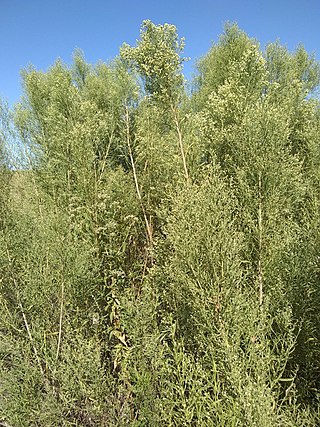
Baccharis is a genus of perennials and shrubs in the aster family (Asteraceae). They are commonly known as baccharises but sometimes referred to as "brooms", because many members have small thin leaves resembling the true brooms. They are not at all related to these however, but belong to an entirely different lineage of eudicots. B. halimifolia is commonly known as "groundsel bush", however true groundsels are found in the genus Senecio.

Baccharis pilularis, called coyote brush, chaparral broom, and bush baccharis, is a shrub in the family Asteraceae native to California, Oregon, Washington, and Baja California. There are reports of isolated populations in New Mexico, most likely introduced.

The American gray flycatcher, or American grey flycatcher, or just gray flycatcher as it is known in North America, is a small, insectivorous passerine in the tyrant flycatcher family. It is common in the arid regions of western North America, especially the Great Basin. From sagebrush steppes to pinyon-juniper woodlands and ponderosa pine forests, this flycatcher forages for insects from shrubs or low tree branches.

Baccharis sarothroides is a North American species of flowering shrub known by the common names broom baccharis, desertbroom, greasewood, rosin-bush and groundsel in English and "escoba amarga" or "romerillo" in Spanish. This is a spreading, woody shrub usually sticky with glandular secretions along the primarily leafless green stems. The small, thick leaves are a few centimeters long and are absent much of the year, giving the shrub a spindly, twiggy appearance. It flowers abundantly with tiny green blooms on separate male and female plants.

Baccharis brachyphylla is a North American species of shrub in the family Asteraceae, known by the common name shortleaf baccharis or false willow. It is native to the southwestern United States and northern Mexico. It grows in desert habitats such as arroyos and canyons.

Baccharis sergiloides is a species of Baccharis known by the common name desert baccharis.

Baccharis vanessae is a rare California species of Baccharis known by the common name Encinitas baccharis. It is native primarily to San Diego County, California, almost endemic to the county except for one population a few miles over the county line in Riverside County. It is a member of the chaparral flora. It is a federally listed threatened species. It is present in several sites in Encinitas, and it is known from other parts of the county from the coastline to the mountains on various substrates. There are perhaps 15 populations remaining, for a total of about 2000 individuals. Some of the remaining occurrences are on land which may be cleared for development.

Dactylotum bicolor, also known as the rainbow grasshopper, painted grasshopper, or the barber pole grasshopper, is a species of grasshopper in the family Acrididae. It is native to the United States, Canada and northern Mexico and exhibits aposematism. It was first described by the German entomologist Toussaint de Charpentier in 1843.

Baccharis neglecta is a species of perennial plant in the family Asteraceae. It is native to northern Mexico and the south-western and south-central United States.

Baccharis salicina is a species of plant in the family Asteraceae. Common names include willow baccharis, and Great Plains false willow. It is a shrub found in North America where it grows in mildly saline areas.

Baccharis angustifolia is a species of North American plants in the family Asteraceae. It is native to the Southeastern United States from Louisiana to North Carolina.

Cirsium wrightii, or Wright's marsh thistle, is an endangered species of North American plants in the family Asteraceae. It is a monocarpic perennial sometimes reaching as much as 300 cm in height.
Ageratina wrightii is a North American species of plants in the family Asteraceae. It is native to the southwestern United States and northern Mexico.
Baccharis bigelovii is a North American species of shrubs in the family Asteraceae known by the common name Bigelow's false willow . It is found in the Chihuahuan Desert and nearby regions of the United States and Mexico, in the States of Chihuahua, Durango, Sonora, Arizona, New Mexico, and Texas.
Baccharis havardii is a North American species of shrubs in the family Asteraceae known by the common name Havard's false willow. It is native to Chihuahua, southern New Mexico, and western Texas.
Baccharis texana is a North American species of shrubs in the family Asteraceae known by the common name prairie baccharis or false willow. It is native to northeastern Mexico and to the southern part of the Great Plains of the United States.
Baccharis thesioides is a North American species of shrubs in the family Asteraceae known by the common name Arizona baccharis. It is widespread in Mexico from Chihuahua to Oaxaca, and also found in the southwestern United States.

Solidago wrightii, commonly known as Wright's goldenrod, is a North American species of goldenrod in the family Asteraceae. It grows in northern Mexico and the southwestern United States.

Hymenothrix wrightii is a North American species of flowering plant in the daisy family. It grows in northwestern Mexico and the southwestern United States.
Krigia wrightii, known as Wright's dwarfdandelion, is a North American species of plants in the family Asteraceae. It is native to the southern Great Plains of the south-central United States.














